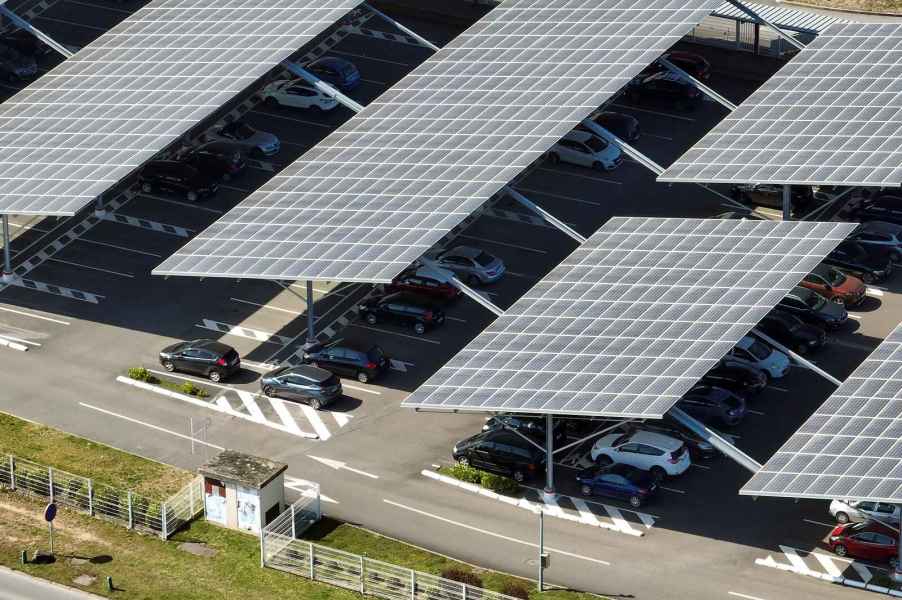
We should be covering parking lots with solar panels
I live in Ohio, which is a particularly flat state. Due to the state’s Heartland location and its soil quality (thanks to the retreating glaciers of the Ice Age), we’re heavy into distribution and agriculture. As such, whichever direction you drive out of Columbus, you’re going to pass a whole lot of industrial complexes, shopping plazas with huge parking lots, and crop fields. Last weekend, I drove to and from Lake Erie. I realized that while some farms around the state have installed those gargantuan dystopian windmills, we still don’t have many solar panels.
In a 2020 Pew survey, 90% of Americans wanted more solar farms. After looking into this more, it turns out there are some “good” reasons why solar-paneled farms and parking lots aren’t as big of a trend as climate activists (and, frankly, the general population) would have liked to see by 2024.
There are several great arguments for installing solar canopies in existing parking lots. For one, the shade provided by the structures would give an excellent reprieve from the elements. Covered parking would shield cars from rain, snow, and oppressively hot days.
Second, solar-paneled canopies could charge EVs parked under them. Joshua Pearce, a professor of electrical and computer engineering at Western University in London, Ontario, spoke with CNET in 2023. He said that a typical Walmart parking lot could house something like 100 EV chargers via solar panel canopies.
Third, parking lots are already-accounted-for zones. In other words, they’re existing structures. As such, they likely won’t be fought over for any other sort of development in the near future. As such, simple cement canopies could convert the parking zones into dual-purpose property. The electricity generated from the panels could power nearby businesses or feed into the local grid.
So, why in the world don’t we see big parking lots covered in solar panels? Well, similar to mass EV adoption barriers, the reasoning is bi-fold. First, the up-front construction and installation costs are difficult to justify or even delegate. Second, the infrastructure “just isn’t there yet.”
Let’s start with regular homes. Some residential homeowners who choose to install solar panels on their roofs face either high up-front costs or some convoluted agreement with the manufacturer or the local power supplier (or both).
For instance, they often agree to send the power generated from the panels to a larger grid. After, they take a discount on their electric bill. In other words, the solar panels you see on American homes often don’t actually directly power that house.
Moving on to farms and parking lots, residential use cases don’t require a whole new structure. Farms and parking lots, however, require new canopy construction, which isn’t cheap. That’s on top of the manufacturing, installation, and maintenance costs of the solar panels themselves.
These days, the manufacturer often retains ownership of the panels while the “client” – whoever owns the property – gets the electricity. Still, building and maintaining the tech needed to get the generated power to the end user is another hurdle. Farms that install solar panel canopies would also need somewhere to connect the power. Parking lots would need either EV chargers or some “pathway” to the grid.
Like many newer technologies, American universities are taking the initiative with solar-paneled parking lots. Michigan State is a good example. Several of its commuter lots have covered parking with large rows of solar panels lined up on top. Of course, the up-front costs were huge and delegated to the solar panel company.
CNET reported an expert saying that building these parking lot canopies is about 40% more than installing solar panels on the ground. What’s more, the university negotiated a power purchase agreement, wherein it pays less than it would if it did business with another entity. So, solar panel companies have fewer motivations to build these canopies on their dime.
In November 2022, France passed a law requiring all owners of nearly any “large” parking lot to install solar panels. By 2028, the parking lot owners would need to cover at least 50% of each lot or encounter not-insignificant monthly fines.
In the U.S., while solar power seems like an obvious, logical way to greener energy, the execution logistics just aren’t there yet. The panels need to be cheap and beneficial enough to install that property owners deem them essential. The power infrastructure needs low-to-none barriers for solar panel entry. Until then, like EVs – which are still too expensive for American drivers to buy new and too “risky” with unreliable charging infrastructure – solar-paneled parking lots as a common feature will remain a “horizon” goal.



